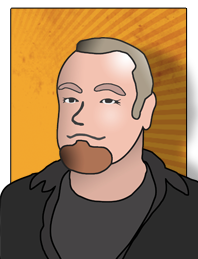Moving the Industry Forward
Our Quest to build the Next Industry Standard
Currently, Craigman Digital is a media service provider to the music and entertainment industries. We create DVDs, Blu-Ray Discs,
and the visual graphic content that goes with them (the menus and the graphic interfaces). Some of these products include the
entire catalogs of DVD-Audio titles from artists such as The Doors, Talking Heads, The Jesus And Mary Chain and R.E.M.
Other specialty products range from designing and programming a USB for the Warner Bros. Records’ 50th Anniversary box set and
the USB that goes with the Tim Burton/Danny Elfman 25th Anniversary box set.
When the music industry was looking for an alternative medium that would bridge the void between the foundering CD and a value-added
product like DVD, it turned to a hybrid solution that could have some real potential. Enter the DualDisc. DualDisc is a double-sided
product with a CD on one side and a DVD on the other, and Craigman Digital pioneered its implementation. Consumers who only wanted
access to the music could insert the CD side to play and/or rip music. For an enhanced experience, one could simply flip the disc over
to watch videos and get other additional content. Because of technical limitations in the CD specification (and some unfortunate choices
made by equipment manufacturers), the DualDisc was deemed spec illegal, and its lifespan saw fewer than 100 titles in the marketplace.
Craigman Digital cofounded the company that created the MVI (Music-Video-Interactive), a DVD-based product that, when placed in a
conventional DVD player, acts like a regular DVD and plays songs from an album and offers videos and other visual content. When placed in
a computer, a software player opens and plays album music and videos, but offers additional content, such as wallpaper, fan photos, applications
for remixing the album audio, and an interface control that permits users to download content to their media experience. When the DVD is
inserted in the computer, the standard 12 songs appear in the media player. When a consumer searches for new content, it is instantly
downloaded to the player, and appears on the DVD’s playlist, and acts as if it’s been there all along. The Warner Music Group produced
about two dozen of these titles in the course of a year.
The second generation of MVI was migrated off of DVD and integrated into a downloadable app using Adobe Air. It came as a light-payload
application that downloaded its content on demand, curating the consumer’s music and videos into a library. At the time, Gracenote (the
creators of the CDDB software that tells you who the artist and songs are when you put a CD in your computer) was developing a similar
application, known as CMX. MVI was already shipping, and its next generation prototype was already in beta. The music industry stalled
when faced with the choice between a proven product from a little known company and the promise of a similar product from Gracenote.
It opted for the latter. CMX is still under review and not shipping – five years later. In fact, Apple’s iTLP, which mimics the MVI in
many ways, has since stepped up to fill the void.
Video Archive and Encoding
In the early 2000s, Craigman Digital designed a digital audio archive approach for the Warner Music Group (we were founded as an audio
production company, after all). With its analog tape masters deteriorating at an alarming rate, WMG was interested in identifying the
correct approach and format with which to digitize its precious assets. Not only would this approach save high-resolution copies of
tens of thousands of two-track tapes, it would also serve as the source platform from which the entire WMG digital catalog would be
distributed to online and physical merchants. Physical CDs, iTunes files and MP3s all originate from this system.
At about the same time, Craigman Digital was charged with the task of creating a similar digitizing system for video files. Digital video
sales were as yet non-existent in the music industry, but with Apple opening its iTunes Music Store to film distribution, music videos
were a perfect fit for that model. Beginning in 2003, Craigman Digital developed a process for digitizing and pre-processing videos
for compression and digital distribution. This process, known as Video Archive and Encoding, or VAE, prepares videos for the distribution
and compression process necessary to send video files to clients’ digital sales chains.
In order to properly prepare videos for the compression farm (the series of computers that compress video for delivery to Amazon, Apple,
Netflix, Verizon and YouTube, to name a few vendors), several requirements must be met. Letterboxing must be removed from widescreen videos,
any format conversion (from PAL to NTSC) must be undone, telecine must be undone where applicable, field order must be properly adjusted,
and (let’s face it) sometimes video editors and directors make mistakes. Any unintended side effects from the video editing and mastering
processes must be removed from the video, lest it be rejected by vendors down the distribution chain. Craigman Digital’s VAE process
ensures that for the many forms of compression used by video product vendors, none will suffer any adverse effects.
In 2003, the demand for music videos was small – about 6 – 10 per week. This was a light enough load to manage manually, using spreadsheets
and email to meet the demand. But as volume grew and turnaround times shrank, asset management became more critical to the VAE process. Enter the Beehive.
The Beehive is a project management system created by Craigman Digital to manage the high volume and short turnaround times required by a growing market.
The Beehive ingests projects – in this case, video encoding jobs – and outlines their workflows, tracks their assets, and assigns tasks to Craigman
Digital's engineers. Users log in to the Beehive to find a to do list for the day, and that list is updated as new projects enter the queue throughout
the day. When a task is finished, the engineer marks it complete and moves on to the next task. When a problem is encountered, the asset is flagged,
the Beehive notifies the client of the problem and given instructions to correct it. Completed files are submitted to the compression farm, which
automatically loads the videos into the client’s distribution queue.
The video processing workload has varied over the years. Our weekly demand has grown from 6 – 10 videos in 2003 to over 100 per week in 2011.
While we once ingested standard definition music videos, standards have changed to high definition videos and even full-length features and concerts.
Processing times can vary from less than an hour to over a day, depending on the asset. Managing the workload across several servers is critical.
Everything is automated with the exception of ingestion from tape, setting up the video parameters, processing the video based on those parameters,
and quality control (having a human watch the video before it is sent to the farm). The processing is executed by compound scripts and applications
which are created by and used by video engineers. We have begun development on a feature that will automatically ingest video processing parameters entered into the Beehive and launch
the applications that will process the video. This feature will also identify available servers in our network and distribute and load balance the
system to increase the efficiency of our processing time.
At Craigman digital, your satisfaction is our reputation. Our goal is deliver the highest quality product possible, have fun while doing it and ensure that you are completely satisfied with your result.
Our knowledgeable staff does its best to ensure that you are well-informed and comfortable with the progress and status of your product during its production cycle, whether it’s a music video or feature film for Blu-Ray or online distribution.

Craig Anderson
President
"One more time, from the top."
As a public expert in the music industry, Craig has forged relationships with musicians, producers, music execs production professionals and hardware manufacturers worldwide. Craig is a vocal advocate of high–resolution audio and video media solutions. He speaks frequently on panels related to digital audio, surround sound music, DVD technology and emerging audio and video delivery formats.
Craig is an active member of the Audio Engineering Society, serves on the Producers and Engineers wing of the RIAA, and is a voting member of the Grammys. Craig also specified and designed a digital audio archive system for the studios at Warner Music Group. A veteran of the film and music industries, his experiences range from audio restoration for Garth Brooks to tracking and editing film scores for Danny Elfman and Tim Burton.
He is passionate about his family, hockey and the outdoors.

David Dieckmann
SVP Video Technology
"Up the voltage..."
David has been working at the turbulent confluence of technology and the arts since 1989. During and after attending Northwestern University in pursuit of a music degree, he worked as an audio engineer recording concerts, recitals, lectures; he played guitar in charlie nobody, Andrew Bird's Bowl Of Fire, and trombone in Kevin O'Donnell's Quality 6; he wrote, recorded, and performed music, developed pieces, and danced for Molly Shanahan in the Mad Shak Dance Company; he worked as a sound designer for theatrical productions including The Real Thing, Macbeth, and Richard II. As an employee of Classic Digital in Chicago (where he met Craig Anderson), as well as an independent engineer, he variously recorded, edited, mastered, and/or produced many albums for such labels as Classic Digital, Cedille Records, Koss Classics, Drag City, Kranky, Carrot Top, Table Of The Elements, among others.
Craig then facilitated David’s move to Los Angeles in 1998 as Craig’s replacement at Audio Intervisual Design in West Hollywood, where David spent 2 ½ years as a systems integration and technical support specialist. He then moved on as an independent engineer, working closely with both Craig and Warner Music Group on the then new product: DVD-Audio. Working with DVD necessitated adding video production, editing, mastering, and compression to his skill set. Within 2 years, David had officially joined Craigman Digital in his current capacity, where they continue to make the world safe for digital entertainment.

Eric Rosloff
Business and Technology
"A noble effort!"
Among the first progeny of the digital age, Eric has been immersed in the world of computers and technology since the earliest days of his youth. Upon reaching his latter teen years, he abandoned traditional academia and set out on a self-directed life path which would lead him through a number of noteworthy adventures. After working on and off in such various modes of gainful employment as video game testing and independent filmmaking, he embarked on perhaps the greatest adventure one can undertake in our capitalist society: starting a business. In December of 2007, Eric and three partners founded a small IT Consulting company which ran for two years before succumbing to the prevailing torrents of general economic maelstrom.
Emerging from the experience as an incredibly more capable individual, Eric wandered again through odd jobs within the entertainment industry before arriving at Craigman Digital, where his background in business and technology has been put to good use.
When not engaging in professional endeavors, Eric indulges his passions for game design, craft beer, and stimulating conversation with good company.

Scott Fitzpatrick
Business and Technology
"
Snatching defeat from the jaws of success.
"
Born and raised in the harsh wilderness of Alaska, Scott began life as a child attracted to sound and technology. When he wasn't defending his claim from rival prospectors or wrestling bears barehanded, Scott was learning the basics of programming from his cousin, a programmer for IBM, and applied those skills to his first job as a web-based application developer for TRW Aerospace Design when he was only 16. After several years of the daily grind of programming, he quickly decided that his life should be devoted to art instead, and spent the next 10 years studying filmmaking at the Los Angeles Film School, graduating in 2002 with a certificate in Editing and Cinematography, as well as music, graduating with a BA in Composition and Classical Guitar from the University of Alaska, Anchorage.
In his professional career, Scott has served as a picture editor for numerous short films and commercials, as well as a single feature film. He has also composed music for university ensembles, as well as music for several short films and web series. He currently produces music for several emerging artists on the side, as well as releasing his own material on his own independent record label. He has performed as a guitarist with independent rock bands, university ensembles, and as a guest member of the Anchorage Symphony.
Scott is a member of ASCAP, the SCL, and the Guitar Foundation of America.
He's also the coolest person on the planet... way better than Dave or Craig. And would probably win in a fist fight against the Hulk and Captain Planet combined.